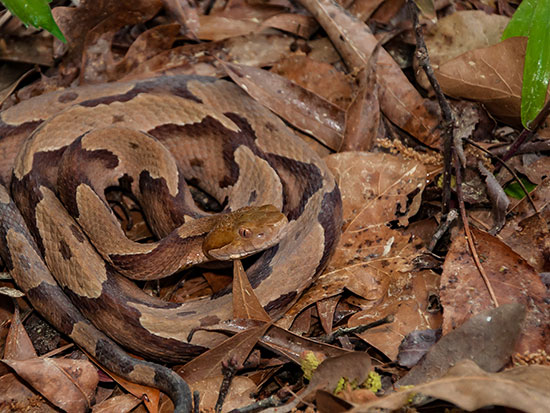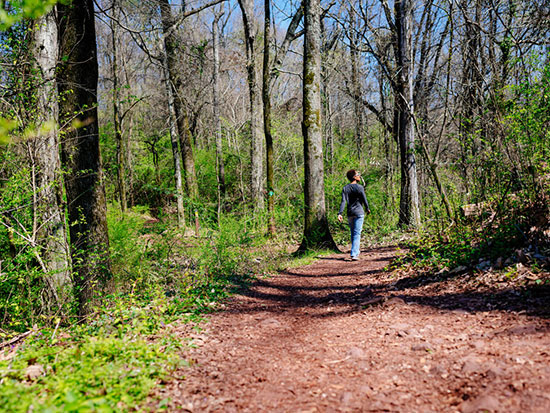 In the immediate aftermath of a snakebite, a natural question is, “Will I die?”
In the immediate aftermath of a snakebite, a natural question is, “Will I die?”
The answer is very likely no, even if the snake is venomous, for reasons explained below. So once the initial shock has passed, there is a better question to ask: Will I be maimed for life?
“So many people — in the southeastern United States, especially — have persistent wounds, bad swelling and morbidity issues after snake envenomation and there was no good place to send them for follow-up,” said William Rushton, M.D. Rushton is a medical toxicologist and the medical director of the Alabama Poison Information Center (APIC), the state’s poison control center, based at Children’s of Alabama hospital. Nearly all snakebites in Alabama trigger a call to APIC. In the heart of snakebite season, in the summer, Rushton and fellow medical toxicologist Sukhshant Atti, M.D., will be doing “one or two snakebite consults every day,” Rushton said. “Most physicians are extremely uncomfortable treating snakebites and doing snakebite follow-up.”
Nothing like it elsewhere
Last year, Rushton and wound-care expert Dag Shapshak, M.D., launched the UAB Comprehensive Snakebite Program, including one of the nation’s first dedicated snakebite follow-up clinics, which treats patients in the hospital, provides follow-up and studies new approaches and protocols in snakebite. Shapshak and Rushton, both associate professors in the Department of Emergency Medicine in the UAB Heersink School of Medicine, are co-directors of the program. They and their team are pioneering new methods that have resulted in greater peace of mind for patients and doctors alike.
To schedule an appointment at UAB, call (800) UAB-8816 or click here. Physicians can access 24-hour consultation and referral services here or by calling (800) 822-6478.
There is nothing like it anywhere else. “This is the nation’s very first comprehensive snakebite program,” said Shapshak, who also runs the UAB Comprehensive Wound Care Clinic, where he specializes in treating persistent wounds and swelling. Shapshak’s typical patient in the Comprehensive Wound Clinic is about 80 years old and dealing with complications from diabetes or cancer. “Our snakebite patients are much younger, from 5 to 30 or so, but the same techniques apply,” Shapshak said. And they can make the difference between lifelong complications and a full recovery.
The snakebite clinic provided follow-up treatment after snake envenomation to 17 patients in 2021. That includes a teenage cheerleader with lingering complications and a truck driver with severe envenomation and necrosis that threatened both his job and his ability to play guitar. “We feel like we have had great success,” Rushton said. The UAB Comprehensive Snakebite Program uses lower doses of antivenom and has shorter patient stays than many other hospitals, typically discharging patients in less than 24 hours. Follow-up visits to the snakebite clinic are now offered to any patient whose care triggers a call to APIC, regardless of insurance status.
Deep thinking on snakebites
The UAB Comprehensive Snakebite Program is staffed by toxicologists, wound-care experts, pharmacists and physical therapists. It cares for adults and children as young as 5 years old and “we will keep seeing people as long as they have persistent wounds and swelling,” Rushton said. “What we’re doing is cutting-edge. No one else is thinking this deeply about snakebites and follow-up.”
“Leaving the hospital after a snake envenomation experience can create a sense of ‘now what?’” said Atti, Rushton’s partner in medical toxicology and associate medical director of APIC. Many patients find their questions unanswered, she says, including Do I elevate my limb?, Do I do physical therapy?, How long will the swelling last? And When can I get back to work? “I believe that having a place to follow up with snake envenomation experts provides comfort to patients that they are not on their own when they leave the hospital,” Atti said.
The clinic is also reassuring for medical providers, adds Matthew Kelly, M.D., co-medical director for Wound Care and Hyperbaric Medicine at UAB. “Snakebites are relatively rare, and any one provider may not see too many patients with complications from snakebites,” Kelly said. “With the snakebite clinic, we are able to see patients from throughout the state, and as with many things, experience is key in understanding the nuances of clinical care.”
Story continues after box
Snakes, death and sunsets
 Snakebite season in Alabama runs from roughly mid-March to mid-November. “Snakes are cold-blooded, so they like to be out when it is around 80 Fahrenheit,” said William Rushton, M.D., co-director of the UAB Comprehensive Snakebite Program. “In Alabama, with our weather, it is usually evenings when people are out and get bitten, rather than early mornings.”
Snakebite season in Alabama runs from roughly mid-March to mid-November. “Snakes are cold-blooded, so they like to be out when it is around 80 Fahrenheit,” said William Rushton, M.D., co-director of the UAB Comprehensive Snakebite Program. “In Alabama, with our weather, it is usually evenings when people are out and get bitten, rather than early mornings.”
The relatively low mortality figures for snakebites in the United States may be surprising — an average of five deaths per year following 7,000–8,000 bites. One reason is that up to 50 percent of snake bites are “dry,” meaning that no venom is released. But the minimal mortality also owes a lot to the widespread availability of antivenom at hospitals where snakebites are common. Nearly all hospitals in Alabama carry a minimal supply of one of the two FDA-approved antivenoms on the market, which bind to the chemicals in snake venoms and obstruct them.
“Internationally, the story is much different,” Rushton said. “More than 100,000 people die each year from snakebite.” And according to statistics from the World Health Organization, around three times as many people annually experience amputations and permanent disabilities caused by bites.
Bites, blood and avoiding the knife
Snakebites in the United States are rarely fatal. During Rushton’s seven years in Alabama, there have been very few snakebite deaths and each of those were relatively unusual circumstances, he says.
Answering the call
The team in the UAB Comprehensive Snakebite Program are the experts, but all physicians in the UAB Department of Emergency Medicine get specialized snake training. Five to seven times a year, Rushton and Atti lead a short course in snakebite care for emergency medicine doctors and doctors-in-training at UAB that includes onsite visits to the snakes at the Birmingham Zoo.
About 10% of envenomations in Alabama are from rattlesnakes, Rushton explains. The rest are from other pit vipers, including copperheads and cottonmouths/water moccasins. (Doctors are quick to distinguish envenomation from the more all-encompassing term snakebite, because up to 50 percent of bites are “dry,” with no venom injected.) The most common complications from envenomation are “local wound damage, swelling of extremities and these severely painful blood blisters,” Rushton said.
When a snake envenomates a person, often on the foot, the tissues fill up with blood, Rushton explains. “For someone with little experience of snakebite,” that swollen leg can look like dead, necrotic tissue that needs to be removed to avoid wider damage. “That’s a hallmark of our program, to keep people away from unnecessary or harmful procedures,” Rushton said. “These large blood blisters are cared for by a wound-care specialist who has specific training of the mechanisms of envenomation. What we don’t want is someone trying to debride [cut away] that tissue, at least early on during active evenomation.”
Overturning misconceptions
The innovative compression and wound dressing techniques that Shapshak, Kelly and their team use in the Wound Clinic are effective for healing snakebite wounds as well, Shapshak says. But this is not intuitive to most physicians. In typical emergency medicine and wilderness medicine courses, physicians are taught to avoid tourniquets and other acute pressure immobilization because it could cause venom to be concentrated and create more damage. “That gets extrapolated to, ‘Oh, you should never have compression,’ even five days out, when the venom is gone,” Shapshak said. “That causes wound breakdown and problems with muscular health, we have found. These patients need soft-tissue wound care and lymphedema [swelling] control primarily, and that is what we specialize in. It’s just that no one had contextualized this to snakebite.” (Shapshak has presented on his experiences with snakebite to national wound-care conferences.)
Breaking new ground in snakebite
How common are residual snakebite complications following hospitalization? No one really knows. In a recent letter to the New England Journal of Medicine, Rushton and Shapshak point out that 10.7% of victims in the North American Snakebite Registry had residual limb deficits, but there was no follow-up information on approximately 40% of the patients in the registry, so the true long-term outcomes are unclear.
One of the goals of the UAB Comprehensive Snakebite Program is to gather this data, as well as new insights on post-bite care. The research and commercial attention in snakebite is mainly on in-hospital care and resuscitation, rather than helping patients regain normal function afterward, Rushton said. “We are focused on needs that have not been met with antivenom and complications that are not being described in the literature.”
Comprehensive, multidisciplinary care
The UAB Comprehensive Snakebite Program focuses on four common post-bite complications:
- persistent swelling of the extremities
- bad blood blisters
- range-of-motion activity
- rebound coagulopathy
The program’s multidisciplinary approach is what truly sets it apart, says co-director William Rushton, M.D. While patients are in the hospital, physical therapists emphasize early range-of-motion exercises and “switching patients over from IV to oral pain meds and getting them out of bed,” Rushton said. “And UAB pharmacy expertise has been crucial with the timing of the antivenom. Patients then get follow-up in our snakebite clinic and the benefit of our research.”
Niki Ritchie, R.N., a Certified Specialist in Poison Information with the Alabama Poison Information Center (APIC), acts as liaison between APIC and the snakebite follow-up clinic “to ensure continuity of longitudinal care,” she said. Ritchie also reviews poison center data to help guide clinic physicians by recommending specialized testing, including identifying patients who need to be screened for rebound coagulopathy, a recurrence of the abnormal blood clotting that occurs after envenomation. This clotting usually improves after antivenom treatment, but can return later.
Jessica Rivera Pescatore, PharmD, a clinical toxicologist and pharmacist in UAB’s emergency department, is often the first member of the Comprehensive Snakebite Program team to reach a patient’s bedside and continues to follow them throughout their care. “Successful antivenom therapy, as is the case with most antidotes, involves tailoring a care plan to each individual case,” she said. By careful monitoring of orders, lab values and limb measurements, she is able “to ensure that antivenom therapy is being provided when indicated and being discontinued when appropriate.” This is important because antivenom carries a risk of serious side effects and is extremely costly.
The Comprehensive Snakebite Program is an innovator in the use of thromboelastography, or TEG, a method of precisely studying blood coagulation, clot strength and clot stability. TEG can provide a more rapid answer than traditional tests, such as prothrombin time and partial thromboplastin time (PTT) tests. Because the Department of Emergency Medicine is a national leader in research, access to TEG is widespread enough that every snakebite patient admitted to UAB can receive the benefit of this technology and have their antivenom titrated appropriately, Rushton notes.
In Alabama and throughout the Southeast, rattlesnakes make up less than 10 percent of envenomations, but rattlesnake bites can cause life-threatening coagulopathy “and we don’t want to miss those,” Rushton said. “The reason we get TEGs on every snakebite patient is to screen for rattlesnake bites that may have been erroneously reported as copperhead bites. If that is the case, we will be more aggressive about giving antivenom, and we use the TEG to titrate the antivenom dose as well.”
Although the evidence is still out on whether or not TEGs “are better than traditional labs,” Rushton said, “we’re seeing that we can predict rattlesnake bites on the thromboelastogram before we can see that from traditional coagulation markers. That way, we can better titrate the amount of antivenom used.”
“Snakebites can be intimidating to treat given all of the various scenarios in which patients can present,” said Sukhshant Atti, M.D., Rushton’s partner in medical toxicology and associate medical director of APIC. “Many community hospitals in the state of Alabama don’t have enough antivenom for more than one loading dose nor the means to care for a critically ill patient from a snake envenomation. This can create a lot of uncertainty for a community physician in trying to decide whether a patient needs to be transferred to another hospital for further care. We’re able to guide physicians in such scenarios, allowing them to make sound decisions.”
 “So many people — in the southeastern United States, especially — have persistent wounds, bad swelling and morbidity issues after snake envenomation and there was no good place to send them for follow-up.”
“So many people — in the southeastern United States, especially — have persistent wounds, bad swelling and morbidity issues after snake envenomation and there was no good place to send them for follow-up.” "These patients need soft-tissue wound care and lymphedema [swelling] control primarily, and that is what we specialize in. It’s just that no one had contextualized this to snakebite.”
"These patients need soft-tissue wound care and lymphedema [swelling] control primarily, and that is what we specialize in. It’s just that no one had contextualized this to snakebite.” “Leaving the hospital after a snake envenomation experience can create a sense of ‘now what?’ I believe that having a place to follow up with snake envenomation experts provides comfort to patients that they are not on their own when they leave the hospital.”
“Leaving the hospital after a snake envenomation experience can create a sense of ‘now what?’ I believe that having a place to follow up with snake envenomation experts provides comfort to patients that they are not on their own when they leave the hospital.” “Snakebites are relatively rare, and any one provider may not see too many patients with complications from snakebites. With the snakebite clinic, we are able to see patients from throughout the state, and as with many things, experience is key in understanding the nuances of clinical care.”
“Snakebites are relatively rare, and any one provider may not see too many patients with complications from snakebites. With the snakebite clinic, we are able to see patients from throughout the state, and as with many things, experience is key in understanding the nuances of clinical care.”